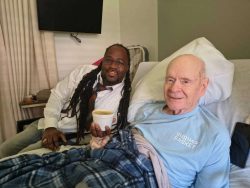
Breezy Kismet Zardin, who is nonbinary and transmasculine, recalls regular abuse by other students.
13:43 JST, April 14, 2023
Cries of “Here comes the ‘it’!” in school hallways. Teachers who refuse to use transgender students’ names and pronouns. Long, isolating walks to faraway gender-neutral bathrooms – or just holding it all day.
These are among the school memories that linger with transgender and nonbinary adults, illuminating the finding from a Washington Post-KFF poll that school is among the greatest stressors for trans children. More than 4 in 10 trans adults in the survey, one of the most sweeping of its kind to date, reported that school made them feel unsafe.
Brandon Scott, a 43-year-old living in Twin Falls, Idaho, who is nonbinary and gender-fluid, said he spent most of school trying to avoid bullies, only to receive worse treatment from teachers who made him feel disgusting and advised him to act like everyone else. He was shoved and shouted at for being gay and for behaving in a traditionally feminine manner, including joining the cheerleading team.
“I just remember school as being this nightmare,” Scott said. “I didn’t want to be there. I didn’t feel included. There, I was the problem.”
The Post-KFF poll is the largest nongovernmental survey of U.S. transgender adults ever conducted using random sampling methods. Between Nov. 10 and Dec. 1 of last year, 515 people who identify as trans answered questions about their experiences growing up and their lives post-transition. More than 800 cisgender adults were also part of the survey.
The poll found that 45 percent of trans adults felt unsafe in school, compared with 37 percent who felt unsafe at religious gatherings, 30 percent who felt unsafe in their homes and 25 percent who felt unsafe participating in youth sports or extracurriculars. In each of these situations, cisgender people were far more likely to report positive experiences, with just 10 percent of cisgender adults recalling feeling unsafe at school.
The results come as the nation debates what children should be able to learn and do at school, and as a GOP-led movement seeks to circumscribe the rights of LGBTQ students. As of late 2022, eight states had passed 15 laws limiting education on gender identity or sexual orientation, per a Post analysis, while 22 states had passed 27 laws barring trans students from sports teams and school facilities that match their gender identities. As of April 10, at least 10 states had enacted laws restricting gender-affirming health care for trans children.
Poor treatment at school can spur mental health crises, curbing academic achievement and generating consequences that span lifetimes. The Post-KFF poll found that, compared with Americans as a whole, trans adults are more than twice as likely to face depression or anxiety growing up. In Idaho, Scott said his sufferings at school led to a suicide attempt at age 15 and decades of substance abuse.
“The negative things that happened in school, they put up a wall for me around education,” he said. “So I sought acceptance other ways: through . . . drugs and alcohol and parts of society you don’t need an education for.”
The Post contacted more than 50 survey participants – and some adults who did not answer the survey – to understand why school is so stressful. Here are the five most common reasons.
Bullying
Breezy Kismet Zardin, a 31-year-old living in Arkansas, grew up feeling like they didn’t fit – not in their own body, nor into the world around them.
Their peers were a big reason.
Zardin, who identifies as nonbinary and transmasculine, said they were regularly beaten up in elementary and middle school by students who called them “gross” and a “Satanist.” Zardin had come out as bisexual by middle school (although today they identify as gay) but had not begun exploring their gender identity, which they lacked the vocabulary to understand.
No one befriended Zardin or sat with them at lunch. In third grade, whenever the teacher left the classroom, two boys would corner Zardin, shove them under the teacher’s desk and ram them with rolling chairs. Other children made a game out of telling teachers Zardin had head lice, leading to hours spent in the nurse’s office while adults inspected Zardin’s scalp.
Zardin adapted by withdrawing: They stopped going to recess. They earned lunchtime detentions so they wouldn’t have to eat with other children. They stopped speaking in class.
In the silence, they began to dislike themself. At 12, they took their first sip of alcohol.
“I just felt like everybody hated me and the things that I did and the fact I was inherently different,” they said. “A lot of self-loathing comes from when you’re surrounded by a huge culture of people that tells you that you’re wrong.”
Drinking became an escape. Zardin turned 15 in rehab. They spent the following two years in and out of treatment. At age 17, increasingly desperate about a life that seemed to be going in all the wrong directions, they decided to make a change: They began dressing “hyper-fem,” wearing tight clothes and high heels and growing their hair long. They even signed with a modeling agency. Conforming to societal gender norms, they thought, might “fix me.”
Suddenly, Zardin was popular, with flocks of friends. Zardin’s parents praised them. Strangers told Zardin they were beautiful. But Zardin didn’t feel beautiful. Zardin felt worse than ever – and drank more than ever. For many years, Zardin went to sleep on their birthday certain they would not live to see the next one.
It took until Zardin’s mid-20s to beat their addiction. With the help of therapy, and after researching what it means to be transgender, Zardin discovered an identity, a style of dress and a set of pronouns that made them feel, finally, like themself.
“I think what kept me alive,” Zardin said, “was realizing that, no, I can’t be anything other than this. So I have to learn how to be this.”
Facilities, names, pronouns
If Mason McElravy closes his eyes, he can see each step of the route he took to the bathroom in high school.
The path traversed his large Florida campus, requiring him to walk by dozens of classrooms and single-sex restrooms, and finished inside the health clinic, home to Plant City High’s only gender-neutral bathroom. The nurses agreed to let him use it, McElravy said, after classmates and staffers repeatedly questioned and opposed his attempts to use the men’s room.
“It just sucked to have to walk that entire way and past everyone in the clinic,” said McElravy, now 22. “I wasn’t sick, I was just using the bathroom. It was ostracizing. It made me stick out.”
McElravy, who identifies as a transgender man, said lack of access to the men’s room was one of several school policies and attitudes that made him feel unwelcome, unaccepted for who he was, and, ultimately, unwilling to learn. McElravy, who socially transitioned at 15, said most teachers and adults at school kept calling him by his old name and female pronouns.
McElravy’s district, Hillsborough County Public Schools, did not respond to a request for comment.
The question of what school facilities transgender students should be allowed to use has become one of the highest-profile political fights in the nation. LGBTQ advocates argue that gender-affirming policies will make school safe for transgender and nonbinary students and boost their mental health. But conservative politicians – and some parents – warn that expanding bathroom and sports team access will threaten female students’ safety and render athletic competitions unfair.
Republicans have proposed a raft of laws that do things like enshrine a strictly biological definition of gender across a wide set of school scenarios. In McElravy’s home state of Florida, the GOP-dominated state legislature is considering a bill – cleared by a key committee in late March – that says school staffers cannot call students by pronouns that differ from those given to them at birth, even if a parent allows it.
That kind of law would be devastating to children, warned Bamby Salcedo, a 53-year-old transgender woman who is president and CEO of the Trans Latino Coalition in Los Angeles. She said the overwhelming majority of transgender teens she has gotten to know through the coalition reported being misgendered and deadnamed by adults in authority at school.
“It really gets right to people’s minds,” said Salcedo, who still remembers how professors misgendered her in college. “It contributes to people feeling not worthy. It affects your mood, your self-esteem, your grades.”
McElravy said hearing the wrong name and pronouns from teachers in school – which happened seven to 10 times a day – made his chest tighten. He trembled and shut his eyes as the room wobbled and his anxiety crescendoed.
It was as though the teachers were telling him: “You’re not real. That part of you isn’t real,” McElravy said.
Eventually, McElravy stopped wanting to go to school. He stopped doing his homework. He got home, fell into bed, blasted music through his headphones and tried to shut his brain off. To forget.
He graduated with a 3.2 grade-point average. He wonders what he could have achieved if he’d been given “the space and the respect to really put all of my attention into academics.” But that never happened.
Enforcement of gender roles and stereotypes
Signs emerged early that Kevin Noble-Ward, now 64, felt wrong in a woman’s body. At 18 months old, he wriggled and cried when his mother tried to clothe him in frilly dresses. His first memories are of fighting his mother over church attendance, begging to don overalls rather than the dress and gloves she demanded.
But the dissonance was sharper at school, where everyone and everything seemed intent on classifying him by gender.
In second grade, teachers divided the class into boys’ and girls’ lines every morning. Under pressure, Noble-Ward joined the girls, confused and frustrated because he knew he really belonged in the other line. In fourth grade, Noble-Ward wanted to join the baseball team but had to make do with the softball team. Everything about playing with women – right down to the team’s name, “The Rockettes” – felt annoying. Eventually, Noble-Ward quit.
Across all grades, the dress code was a source of daily irritation. Noble-Ward wore a plaid dress but coveted the jeans and corduroys permitted to boys. Gym class, when he was allowed to wear pants under his dress, was a fleeting relief.
“Those were the days I felt most comfortable,” Noble-Ward said. “But I can’t remember a day that I didn’t feel a lot of anxiety when I went to school. I always had stomachaches, just physical aches.”
He rebelled in tiny ways. At home, he daydreamed about choosing a male name, favoring “Rowdy,” which he gleaned from watching westerns on TV. He built model airplanes or chose to enact the role of father when playing house with other girls. He insisted on keeping his hair short, despite his mother’s protests.
“School was always where I felt worst,” Noble-Ward said. “If that had been better, I think my mental health – I think my whole life could have been better.”
As an adult, Noble-Ward twice almost died by suicide, nearly driving into a bridge and into oncoming traffic. Nothing made him feel whole, not until he socially transitioned at 61.
Ignorance of LGBTQ topics
Growing up in Hawaii, Kane Ruiz never learned about being LGBTQ from teachers at school. Instead, Ruiz, now 20 and a transgender man, obtained his information online, mostly from Instagram accounts.
When Ruiz hit his junior year of high school – by which time he had socially transitioned – the teacher of a health class approached him with a question. Would he consider leading lessons on what it means to be LGBTQ?
Ruiz believed the teacher – as was the case with most educators on his campus – knew little about the LGBTQ community, but Ruiz thought education was the only way to eradicate prejudice.
So he stepped to the front of the room and explained to his peers what “LGBTQ” stands for, how transgender people are different from drag performers (“because occasionally people will think they’re the same”) and how nonbinary people do not have to look androgynous.
But Ruiz knows not every LGBTQ student would have felt comfortable in such a prominent role. And he wishes his assistance had not been required: “Students will take it more seriously if it’s from a teacher.”
Ruiz’s experiences reflect the state of sex and health education across America, which more often than not leaves out discussions of LGBTQ lives. Just nine states have policies mandating instruction on LGBTQ identities and sexual health for LGBTQ youths, according to a 2022 report from the advocacy group SIECUS: Sex Ed for Social Change.
Max Rearden, a 25-year-old nonbinary person in Rockford, Ill., said he discovered the term “nonbinary” in college, when he saw it listed on a club poster and decided to investigate. He said he wishes he’d learned about LGBTQ people years before – even something as simple as an acknowledgment that transgender people exist.
“It would have given me the opportunity to ask other questions about myself that I didn’t ask until later on,” Rearden said, “which in turn would have prepared me better for being an adult.”
Anna Hursley, a 40-year-old transgender woman in North Carolina, said learning about LGBTQ people in school would have hastened her transition, which she began late in life at 38: “I would have felt more comfortable in my body much sooner.”
Ruiz came out as transgender at 15, drawing support from his school and most classmates. Only once did he have a scarring interaction, when a boy filmed him washing his hands in the men’s room while asking in a loud voice, “Why is a girl in the boys’ room?” After that, Ruiz stopped using the men’s room.
Still, Ruiz said he failed for years to understand his gender, causing stress and pain. Some of this could have been alleviated if his school had offered education on LGBTQ issues, he believes. (The nine states that offer these sorts of lessons generally teach that “gender can be understood to have several components, including gender identity, gender expression and gender roles,” per SIECUS.)
If the boy in the restroom had learned about transgender people at school, Ruiz said, he might not have pulled out his phone and started filming.
Callous adults
Scott, the nonbinary 43-year-old in Idaho, knows why he is alive today.
The reason is Mrs. Hansing-Brock, the teacher who let him take home economics classes, where he learned to sew and cook alongside female classmates. Hansing-Brock also told Scott stories about her gay friends, adults leading successful lives – stories that gave Scott hope he could someday find happiness, too.
But she was the exception. Most teachers Scott knew were mean or dismissive. One English teacher rolled his eyes and scoffed whenever he saw Scott. A school counselor he asked for help with bullying told him, in words he will never forget, “Just don’t act this way, just stuff that part of yourself down and put it away.”
“The teachers were worse than the students,” Scott said.
Three decades later, not much has changed, McElravy said. Dressing and presenting as male did not stop teachers from naming him a woman. Administrators who knew the answer stopped him outside the bathroom to ask, “Why are you going in the men’s room?” A guidance counselor told him she completely understood what he wanted, before asserting: “So it’s just whatever pronouns people want to call you. I get it!”
It wasn’t just the teachers, Scott said. Parents he knew and politicians he watched on TV, inflamed by the 1990s-era debate over the U.S. military’s “don’t ask, don’t tell” policy – which allowed LGBTQ men and women to serve so long as they kept their sexual identity hidden – were having a conversation about gay and bisexual people that Scott found noxious.
Whenever Scott flipped on cable television at home, he imbibed a clear message: “That ‘LGBTQ people are gross.’ It solidified that the country was really against us and you had no standing to become anything in the world.”
He sees parallels to conflicts over transgender student rights, education, health care and sports participation now taking place across society, from state legislatures to school board meetings.
“The same thing,” he warned, “is happening again.”
If you are transgender and need help, or know someone who does, call the Trans Lifeline at 877-565-8860. You can also reach crisis counselors at The Trevor Project for LGBTQ youth by calling 866-488-7386 or texting “START” to 678678, and by calling the 988 Suicide & Crisis Lifeline at 988.
Methodology
The Washington Post-KFF Trans Survey was conducted in English and Spanish from Nov. 10 to Dec. 1, 2022, among 515 U.S. adults who identify as trans and 823 cisgender U.S. adults. Sampling, data collection, weighting and tabulation were managed by SSRS. Trans adults were reached via three survey panels recruited using random sampling methods: The Gallup Panel, NORC’s AmeriSpeak Panel and the SSRS Opinion Panel. Additional trans respondents were recontacted from previous randomized telephone interviews. Cisgender adults were recruited through the SSRS Opinion Panel. Results among the sample of trans adults have a margin of sampling error of plus or minus seven percentage points and the margin of sampling error is plus or minus four percentage points among the sample of cisgender adults.
"News Services" POPULAR ARTICLE
-

American Playwright Jeremy O. Harris Arrested in Japan on Alleged Drug Smuggling
-

Taiwan President Shows Support for Japan in China Dispute with Sushi Lunch
-

Japan’s Nikkei Stock Average as JGB Yields, Yen Rise on Rate-Hike Bets
-

Japan’s Nikkei Stock Average Licks Wounds after Selloff Sparked by BOJ Hike Bets (UPDATE 1)
-

Japanese Bond Yields Zoom, Stocks Slide as Rate Hike Looms
JN ACCESS RANKING
-

Japan’s Hopes for Seafood Exports Shot Down in China Spat
-

Keidanren Chairman Yoshinobu Tsutsui Visits Kashiwazaki-Kariwa Nuclear Power Plant; Inspects New Emergency Safety System
-

Japan to Charge Foreigners More for Residence Permits, Looking to Align with Western Countries
-

Imports of Rare Earths from China Facing Delays, May Be Caused by Deterioration of Japan-China Relations
-

Japan Exports Rise in October as Slump in U.S. Sales Eases

























